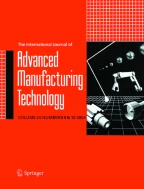Abstract
A method for surface quality evaluation and temperature monitoring of the billet in continuous casting is considered in this paper. This method uses the difference between the measured and the filtered temperature computed using an adaptive support vector machine method. The temperature field, measured by an infrared camera, is affected by an important noise called calamine (a metal oxide generated during the cooling process). The quality of the billet’s surface temperature is connected to the secondary cooling behavior, and therefore an evaluation of the calamine effect is needed. Methods such as soft sensing and adaptive support vector machine are used for a global evaluation of calamine intensity on the monitored area of the billet in continuous casting. This kind of approaches is applied in continuous casting process for constructing a complementary condition monitoring system, which allows an online calamine evaluation. Simulation results, based on the measured surface temperature and the adaptive support vector machine analysis, showed that this new combined approach is easily implementable and gives good results when applied online.
Similar content being viewed by others
References
El-Bealy M, Leskinen N, Fredriksson H (1995) Simulation of cooling conditions in secondary cooling zones in continuous casting process. Ironmak Steelmak 22(3):246
Holger B (1994). Computersimulation thermischer und mechanischer Vorgänge beim Brammenstranggießen von Stahl, Dissertation Dr-Ing No. 94.10186/3 Bergakademie Freiberg
Biao W, Zhen-ping JI, Wen-hong LIU, Jiao-cheng MA, Zhi XIE (2008) Application of hot strength and ductility test to optimization of secondary cooling system in billet continuous casting process. J Iron Steel Res Int 15(4):16–20
Sigeru K (1984) On the secondary cooling control technology for the continuous casting-direct rolling processes. Nippon Steel Tech Rep 23:69
Bast J, Bouhouche S (1997) Mathematishe Modellierung einer Strangießanlage Freiberger Forschungshefte Automatisierung in der Montanindudtrie Freiberg Germany. A839: 37
Ji C, Zhu M, Cao X, Luo S (2011) Research and application of soft reduction amount online calculation model for bloom continuous casting process. Proceeding METEC2011. Dusseldorf: 27 June–1 July.
Raclevsky M, Válek L (2011) Metal level behaviour in continuous casting tundishes. Proceeding METEC2011, Dusseldorf: 27 June–1 July
Barlocco C (1983) Projet d’un système d’automatisation du refroidissement secondaire en coulée continue. Révue de Métallurgie CIT 12:947
Harste K (1996) Process control and strand condition monitoring at Dillinger Hüttenwerke. Révue de Métallurgie CIT 4:1241
Lamp T, Köchner H (2011) Optical monitoring of initial solidification in a billet continuous casting mould. Proceeding METEC2011. Dusseldorf: 27 June–1 July
Craig IK, Camisani-Calzolari FR, Pistorius PC (2001) A contemplative stance on the automation of continuous casting in steel processing. Control Eng Pract 9:1013–1020
Marjanovic O, Lennox B, Sandoz D, Smith K, Crofts M (2006) Real-time monitoring of an industrial batch process. Comput Chem Eng 30:1476–1481
Zhang Y, Dudzic MS (2006) Industrial application of multivariate SPC to continuous caster start-up operations for breakout prevention. Control Eng Pract 14:1357–1375
Dukman L, Moon CH, Moon SC, Park HD (2009) Development of healing control technology for reducing breakout in thin slab casters. Control Eng Pract 17:3–13
Manabu K, Nakagawa Y (2008) Data-based process monitoring, process control, and quality improvement: recent development and applications in steel industry. Comput Chem Eng 32:12–24
Xuan TD, Srinivasan R (2008) Online monitoring of multi-phase batch processes using phase-based multivariate statistical process control. Comput Chem Eng 32:230–243
Kadlec P, Gabrys B, Strandt S (2009) Data-driven soft sensors in the process industry. Comput Chem Eng 33:795–814
Vesanto J (2000) Using SOM in data mining. Licentiate thesis, Helsinki University of Technology
Kohonen T (2001) Self-organizing maps. Springer, Heidelberg
Chiang LH, Russell EL, Braatz RD (2001) Fault detection and diagnosis in industrial systems, 2nd edn. Springer, London Berlin Heidelberg
Bouhouche S, Lahreche M, Moussaoui A, Bast J (2007) Quality monitoring using principal component analysis and fuzzy logic. Application in continuous casting process. Am J Appl Sci 4:637–644
Xuan TD, Rajagopalan S (2008) Online monitoring of multi-phase batch processes using phase-based multivariate statistical process control. Comput Chem Eng 32:230–243
Bouhouche S, Laib LY, Bast J (2010) Evaluation-based online support vector machine and fuzzy reasoning. Application to condition monitoring of speeds rolling. Control Eng Pract 18:1060–1068
M. Haag (2005) Autocorrelation of random processes. http://cnx.org/content/m10676/latest/. Accessed Apr 2005
Kourti T, Nomikos P, MacGregor JF (1995) Analysis, monitoring and fault diagnosis of batch processes using multiblock and multiway. J Process Control 5:277–278
Ge Z, Song Z (2008) Online monitoring of nonlinear multiple mode processes based on adaptive local model approach. Control Eng Pract 16:1427–1437
Manabu K, Yoshiaki N (2008) Data-based process monitoring, process control, and quality improvement: recent development and applications in steel industry. Comput Chem Eng 32:12–24
Faggian A, Facco P, Doplicher F, Bezzo F, Barolo M (2009) Multivariate statistical real-time monitoring of an industrial fed-batch process for the production of specialty chemicals. Chem Eng Res Des 87:325–334
Vapnik VN (1995) The nature of statistical learning theory. Springer, Heidelberg
Ceperic V, Gielen G, Baric A (2012) Sparse multikernel support vector regression machines trained by active learning. Expert Syst Appl 39:11029–11035
Li MZZ, Li W (2005) Study on least squares support vector machines algorithm and its application. Proceedings of the 17th IEEE International Conference on tools with artificial intelligence: 1082–3409
Desai K, Badhe Y, Tambe SS, Kulkarni BD (2006) Soft sensor development for fed batch bioreactors using support vector regression. Biochem Eng J 27(3):225–239
David LO, Dursun D (2008) Advanced data mining techniques. Springer, Heidelberg
Author information
Authors and Affiliations
Corresponding author
Rights and permissions
About this article
Cite this article
dit Leksir Yazid, L., Salah, B., Seghir, B.M. et al. Adaptive support vector machine-based surface quality evaluation and temperature monitoring. Application to billet continuous casting process. Int J Adv Manuf Technol 67, 2063–2073 (2013). https://doi.org/10.1007/s00170-012-4631-0
Received:
Accepted:
Published:
Issue Date:
DOI: https://doi.org/10.1007/s00170-012-4631-0
